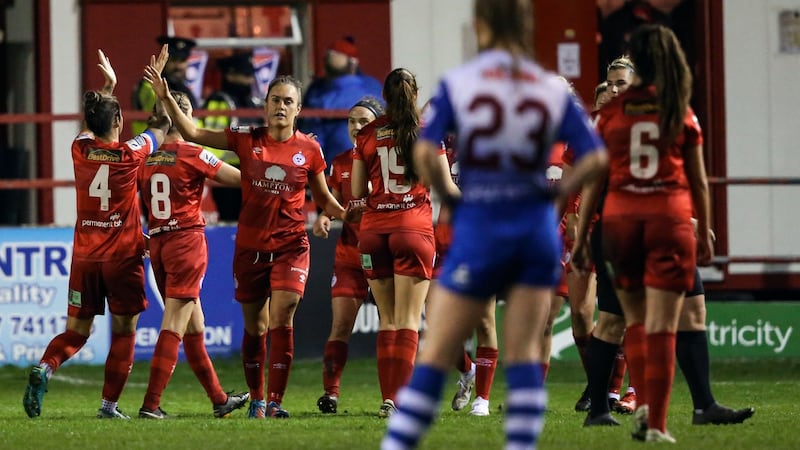Last season’s final day showed us what the women’s game in Ireland can become. It had goals, crowds, shocks, visibility and a massive online interaction.
It generated column inches on sports websites and the national newspapers were not merely ticking boxes, because here was a real sports story; Galway’s shock defeat of Peamount United in Greenogue resulted in Shelbourne lifting the trophy but only after a mad dash across the city with the silverware.
Following an exciting and enthusiastic start to the men’s national league, this weekend the SSE Airtricity women’s national league returns. Never before can I remember seeing so much promotion of the WNL preceding the campaign and the hope is that it continues all the way through this year.
The women’s FAI Cup final was also broadcast on national television last year and again, it was a thrilling game that did not disappoint. Wexford Youths, inspired by captain Kylie Murphy defeated Shels to win their fourth FAI cup since 2015 with Murphy subsequently named the first ever winner of the new soccer writer’s of Ireland (SWAI) women’s award.
That in itself was significant.
It was a long time coming, but at least there is now a formal recognition by the football journalist fraternity of the positive impact they can make for the women’s game in this country.
These small things become the big things making a huge difference over time. It’s also good to see some of the top sports writers in this country attending women’s games and reporting on them personally. Again, this can have a massive impact over time.

The challenges for a female player to make it to the top level of the game in this country can be far greater than those experienced by their male counterparts. Many players train as often as the semi-professional League of Ireland man but with far less resources available to them in terms of sports science, physiotherapy and quality of training facilities.
And more often than not, they are not paid for their time or reimbursed for the expenses they incur while missing important hours in their day job. All this is done just to play at the highest level of the game in this country.
More work needed
It’s not enough for a club to have a women’s team. The women’s team should have access to the same resources as the men’s first team. Every cent of funding received for women’s football should be put into the women’s section of the club or into ensuring equal access to resources, training and match facilities.
Until clubs achieve this, they are sending out a clear message that the women’s game is not as important to them as the men’s game.
Their actions are telling women, in domestic Irish football, that they remain second class citizens. Or lower.
Substandard terms of integration should not be grounds for acceptance. I have said it previously, women’s football should not be grateful for crumbs. Clubs need to see a women’s first team as an investment, not an expense.
It starts at home. Is the male coach/father giving his daughter the same opportunity as his son to play football, and if not why not?
There is incredible work going on all across the country to develop our young female players and there has been for years. These are devout people who pay for their own coaching courses and volunteer their time to develop young talents.
Talent
There are many clubs that are putting energy and resources into developing women’s and girl’s teams and we know this is happening because we are seeing some incredibly talented players coming through the ranks. For example, Wexford’s Ellen Molloy (17) and Shels’ Abbie Larkin (16), both featured for Vera Pauw’s Republic of Ireland last month.
The problem is that these players come through the domestic ranks only to disappear for the price of a one-way Ryanair flight to the UK.
It’s not sustainable and it’s not good business. The time is now for clubs to start making their women’s national league teams semi-professional, at the very least.
Senior Ireland internationals Katie McCabe (Arsenal - former Raheny, Shelbourne, Templeogue United), Denise O’Sullivan (North Carolina Courage - former Cork City, Peamount, Wilton Utd), Diane Caldwell (Manchester United - former Raheny, Balbriggan FC), Niamh Fahey (Liverpool - former Galway WFC, Salthill Devon), Louise Quinn (Birmingham City - former Peamount Utd, Lakeside, Blessington Boys FC) all came through the club scene in Ireland before moving on to fruitful and successful careers as professional footballers at the highest level of the game.
In the last year, Jamie Finn (Birmingham City), Izzy Atkinson (Glasgow City), Niamh Farrelly (Glasgow City), Emily Whelan (Birmingham City) and Eleanor Ryan-Doyle (Birmingham City) all moved across the water.
How long before players like Molloy, Jessie Stapleton, Aoibheann Clancy and Jessica Ziu follow them, because they are all good enough to start professional careers?
The incredible work that has gone on, often under the radar, in girls football over the last decade has provided the game with its biggest opportunity ever. What an exciting prospect it will be for those who have the vision to shape the future by investing in what they do now. Again, it is about doing the small things that will make a lasting difference over time.












